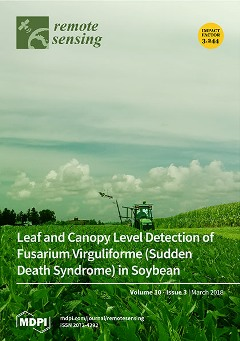In this study, the MODerate resolution Imaging Spectroradiometer (MODIS) Collections 6 and 6.1 merged Dark Target (DT) and Deep Blue (DB) aerosol products (DTB
C6 and DTB
C6.1) at 0.55 µm were validated from 2004–2014 against Aerosol Robotic Network (AERONET) Version 2 Level 2.0 AOD obtained from 68 global sites located over diverse vegetated surfaces. These surfaces were categorized by static values of monthly Normalized Difference Vegetation Index (NDVI) observations obtained for the same time period from the MODIS level-3 monthly NDVI product (MOD13A3), i.e., partially/non–vegetated (NDVI
P ≤ 0.3), moderately–vegetated (0.3 < NDVI
M ≤ 0.5) and densely–vegetated (NDVI
D > 0.5) surfaces. The DTB
C6 and DTB
C6.1 AOD products are accomplished by the NDVI criteria: (i) use the DT AOD retrievals for NDVI > 0.3, (ii) use the DB AOD retrievals for NDVI < 0.2, and (iii) use an average of the DT and DB AOD retrievals or the available one with highest quality assurance flag (DT: QAF = 3; DB: QAF ≥ 2) for 0.2 ≤ NDVI ≤ 0.3. For comparison purpose, the DTB
SMS AOD retrievals were included which were accomplished using the Simplified Merge Scheme, i.e., use an average of the DT
C6.1 and DB
C6.1 AOD retrievals or the available one for all the NDVI values. For NDVI
P surfaces, results showed that the DTB
C6 and DTB
C6.1 AOD retrievals performed poorly over North and South America in terms of the agreement with AERONET AOD, and over Asian region in terms of retrievals quality as the small percentage of AOD retrievals were within the expected error (EE = ± (0.05 + 0.15 × AOD). For NDVI
M surfaces, retrieval errors and poor quality in DTB
C6 and DTB
C6.1 were observed for Asian, North American and South American sites, whereas good performance, was observed for European and African sites. For NDVI
D surfaces, DTB
C6 does not perform well over the Asian and North American sites, although it contains retrievals only from the DT algorithm which was developed for dark surfaces. Overall, the performance of the DTB
C6.1 AOD retrievals was significantly improved compared to the DTB
C6, but still more improvements are required over NDVI
P, NDVI
M and NDVI
D surfaces of Asia, NDVI
M and NDVI
D surfaces of North America
, and NDVI
M surfaces of South America. The performance of the DTB
SMS retrievals was better than the DTB
C6 and DTB
C6.1 retrievals with 11–13% (31%) greater number of coincident observations, 6–9% (14–22%) greater percentage of retrievals within the EE, and 30–100% (46–100%) smaller relative mean bias compared to the DTB
C6.1 (DTB
C6) at a global scale.
Full article





